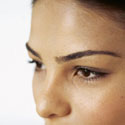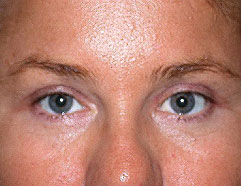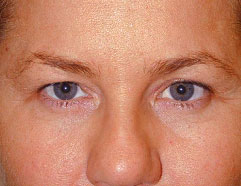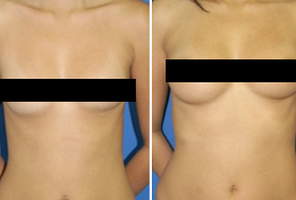The effects of aging often manifests in the forehead as an increase in skin transverse wrinkles and a increasing prominence over the eyebrow. Forehead rejuvenation and correction of droopy eyebrows can be corrected by a forehead lift, also called brow lift. A brow lift will NOT improve baggy eyelids, puffy eyes, or crows feet around the corners of the eyes.

In this surgical procedure, the muscles and tissues that cause the furrowing or drooping are removed or altered to smooth the forehead, raise the eyebrows and minimize frown lines. Two methods that are used that can help achieve this rejuvenation is 1) using an endoscope through small incisions and lifting the muscle and skin layers of the forehead and 2) an open technique with the classic incision that's hidden behind the hairline, or in some cases, above the brow or in the mid-forehead. Although, endoscopic brow lift's are more popular, all patients are not candidates for this type of a brow lift.
Am I a Candidate for a forehead/brow lift?
A forehead lift can help people of any age who have developed furrows or frown lines due to aging, stress, or increased forehead muscle activity. It is often performed in conjunction with a facelift to provide a smoother overall look to the face. Eyelid surgery (blepharoplasty) may also be performed at the same time as a forehead lift, especially if a patient has significant skin overhang in the upper eyelids. Sometimes, patients who believe they need upper-eyelid surgery find that a forehead lift better meets their surgical goals.
Patients with a receding hairline or those who are bald may still be good candidates for forehead lift. In these cases, the surgeon may have to alter the incision location or perform a more conservative operation.
Successful facial plastic surgery is a result of good rapport between patient and surgeon. Trust, based on realistic expectations and exacting medical expertise, develops in the consulting stages before surgery. Your surgeon can answer specific questions about your specific needs. More Brow Lift & Forhead Lift Facts...
What is the difference between a classic forehead lift or an endoscopic lift?
During your consultation, the surgeon will examine your facial structure, the condition of your skin, and your hairline. A thorough medical and surgical history will be obtained so that your surgeon can consider any medical conditions that may heighten surgical risks. This information will help your surgeon come to a decision about which surgical approach will best achieve your cosmetic goals: the classic or "open" method, or the endoscopic forehead lift. Make sure you understand the technique that your surgeon recommends and why he or she feels it is best for you.
The main difference among the various options for forehead lifting consists of the placement of the incision.
- The classic forehead lift
The original technique consists of making a coronal incision, which is made slightly behind the natural hairline. It follows a headphone-like pattern, starting at about ear level and running across the top of the forehead and down the other side of the head. Because the incision is placed behind the hairline, it is typically not visible. An alternative is the pre-trichial incision. This is similar to the coronal incision except that the mid-portion of the incision is made directly at the hairline. This incision generally heals favorably and has the advantage of lowering the hairline. The disadvantage could be noticeable scarring. An option is to place the incision within the midforehead creases. This is primarily used in men with deep pre-existing forehead lines.
If you are bald or have thinning hair, your surgeon may use a mid-scalp incision so the resulting scar follows the natural junction of your skull bones and is less noticeable.
Regardless of the incision used, the operative technique of the actual "lift" is the same. The skin of the forehead is carefully lifted so that the underlying tissue can be removed and the muscles of the forehead can be altered or released. The eyebrows may also be elevated and excess skin at the incision point will be trimmed away to help create a smoother, more youthful appearance.
The incision is then closed with stitches or clips. Your face and hair will be washed to prevent irritation and the rubber bands will be removed from your hair. Although some plastic surgeons do not use any dressings, your doctor may choose to cover the incision with gauze padding and wrap the head in an elastic bandage. More Brow Lift & Forehead Lift Facts... - The endoscopic forehead lift
This is the newest approach and often the most popular, however, not all patients are candidates for this procedure. An endoscopic brow lift is less invasive and results in a smaller chance of temporary scalp numbness, it may result in a longer operation.
In this procedure, several small one-half-inch to one-inch incisions are placed just behind the hairline instead of making one long coronal incision. An endoscope, which is a pencil-like camera device connected to a television monitor, is inserted through one of the incisions, allowing the surgeon to have a clear view of the muscles and tissues beneath the skin. Using another instrument inserted through a different incision, the forehead skin is lifted and the muscles and underlying tissues are removed or altered to produce a smoother appearance. The eyebrows may also be lifted and secured into their higher position by sutures beneath the skin's surface or by temporary fixation screws placed behind the hairline.
When the lift is complete, the scalp incisions will be closed with stitches or clips and the area will be washed. Gauze and an elastic bandage may also be used, depending on your surgeon's preference.
What are the risks/concerns of this operation?
Complications are rare and usually minor when a forehead lift is performed by a qualified plastic surgeon. Yet, the possibility of complications must be considered.
In rare cases, the nerves that control eyebrow movement may be injured on one or both sides, resulting in a loss of ability to raise the eyebrows or wrinkle the forehead. Additional surgery may be required to correct the problem.
Formation of a broad scar is also a rare complication. This may be treated surgically by removing the wide scar tissue so a new, thinner scar may result. Also, in some patients, hair loss may occur along the scar edges.
Loss of sensation along or just beyond the incision line is common, especially with the classic forehead lift procedure. It is usually temporary, but may be permanent in some patients.
Infection and bleeding are very rare, but are possibilities.
If a complication should occur during an endoscopic forehead lift, your surgeon may have to abandon the endoscopic approach and switch to the conventional, open procedure, which will result in a more extensive scar and a longer recovery period. To date, such complications are rare -- estimated at less than 1 percent of all endoscopy procedures.
You can reduce your risk of complications by closely following your surgeon's instructions both before and after surgery. More Browlift & Forehead Lift Facts...
What type of anesthesia is used?
Most forehead lifts are performed under local anesthesia, combined with a sedative to make you drowsy. You'll be awake but relaxed, and although you may feel some tugging and mild discomfort, your forehead will be insensitive to pain.
Some surgeons prefer to use general anesthesia, in which case you'll sleep through the entire operation.
Of course, there are always complications related to anesthesia which is often predicated on your medical condition, and past experiences with anesthesia. More Brow Lift & Forehead Lift Facts...
What is my recovery like?
The immediate post-operative experience for a patient who has had a classic forehead lift may differ significantly from a patient who had the procedure performed endoscopically.
Those who had a classic incision, may experience some numbness and temporary discomfort around the incision. As the nerves heal, numbness on the top of your scalp may be replaced by itching. These sensations may take as long as six months to fully disappear. If bandages were used, they will be removed a day or two after surgery. Most stitches or clips will be removed within two weeks, sometimes in two stages.
Some of your hair around the incision may fall out and may temporarily be a bit thinner. Normal growth will usually resume within a few weeks or months. Permanent hair loss is rare.
Those who went through an endoscopic lift may also experience some numbness, incision discomfort and mild swelling. However, incision site pain is usually minimal. Endoscopic forehead lift patients usually experience less of the itching sensation felt by patients who have had the classic forehead lift.
The stitches or staples used to close the incisions are usually removed within a week and the temporary fixation screws within two weeks.
You will also experience a certain amount of swelling and bruising in the 10-day period following surgery. In some patients, this condition may include the cheek and eye area as well as the forehead. You will be advised to keep your head elevated in order to reduce swelling. Cold compresses may further reduce swelling. More Brow Lift & Forehead Lift Facts...
When will I return to normal?
It is important to follow the advice of your surgeon on resuming normal activities. For most patients, the recovery time will not exceed two weeks. Endoscopic patients may feel ready to return even sooner. Vigorous physical activity should be limited for several weeks, including jogging, bending, heavy housework, sex, or any activity that increases your blood pressure. Prolonged exposure to heat or sun should be limited for several months.
You should be able to shower and shampoo your hair within two days, or as soon as the bandage is removed.
Most of the visible signs of surgery should fade completely within about three weeks. Minor swelling and bruising can be concealed with special camouflage makeup. You may feel a bit tired and let down at first, but your energy level will increase as you begin to look and feel better. More Brow Lift & Forhead Lift Facts...
Disclaimer:
This information is intended only as an introduction to this procedure. This information should not be used to determine whether you will have the procedure performed nor does it guarantee results of your elective surgery. Further details regarding surgical standards and procedures should be discussed with your physician.



